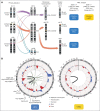Biological and clinical determinants shaping heterogeneity in mantle cell lymphoma
- PMID: 38748869
- PMCID: PMC11284685
- DOI: 10.1182/bloodadvances.2023011763
Biological and clinical determinants shaping heterogeneity in mantle cell lymphoma
Abstract
Mantle cell lymphoma (MCL) is an uncommon mature B-cell lymphoma that presents a clinical spectrum ranging from indolent to aggressive disease, with challenges in disease management and prognostication. MCL is characterized by significant genomic instability, affecting various cellular processes, including cell cycle regulation, cell survival, DNA damage response and telomere maintenance, NOTCH and NF-κB/ B-cell receptor pathways, and chromatin modification. Recent molecular and next-generation sequencing studies unveiled a broad genetic diversity among the 2 molecular subsets, conventional MCL (cMCL) and leukemic nonnodal MCL (nnMCL), which may partially explain their clinical heterogeneity. Some asymptomatic and genetically stable nnMCL not requiring treatment at diagnosis may eventually progress clinically. Overall, the high proliferation of tumor cells, blastoid morphology, TP53 and/or CDKN2A/B inactivation, and high genetic complexity influence treatment outcome in cases treated with standard regimens. Emerging targeted and immunotherapeutic strategies are promising for refractory or relapsed cases and a few genetic and nongenetic determinants of refractoriness have been reported. This review summarizes the recent advances in MCL biology, focusing on molecular insights, prognostic markers, and novel therapeutic approaches.
© 2024 by The American Society of Hematology. Licensed under Creative Commons Attribution-NonCommercial-NoDerivatives 4.0 International (CC BY-NC-ND 4.0), permitting only noncommercial, nonderivative use with attribution. All other rights reserved.
Conflict of interest statement
Conflict-of-interest disclosure: M.D. has received research support from AbbVie, Bayer, Bristol Myers Squibb (BMS)/Celgene, Gilead/Kite, Johnson & Johnson Innovative Medicine, Lilly, and Roche; speakers honoraria from AstraZeneca, BeiGene, Gilead/Kite, Janssen, Lilly, Novartis, and Roche; and serves on scientific advisory board for AbbVie, AstraZeneca, BeiGene, BMS/Celgene, Gilead/Kite, Janssen, Lilly/Loxo, Novartis, and Roche. The remaining authors declare no competing financial interests.
Figures


References
-
- Swerdlow SH, Campo E, Harris NL, et al. 4th ed. IARC; 2017. WHO Classification of Tumours of Haematopoietic and Lymphoid Tissues.
-
- Silkenstedt E, Dreyling M. Mantle cell lymphoma-update on molecular biology, prognostication and treatment approaches. Hematol Oncol. 2023;41(suppl 1):36–42. - PubMed
Publication types
MeSH terms
Substances
LinkOut - more resources
Full Text Sources
Research Materials
Miscellaneous

